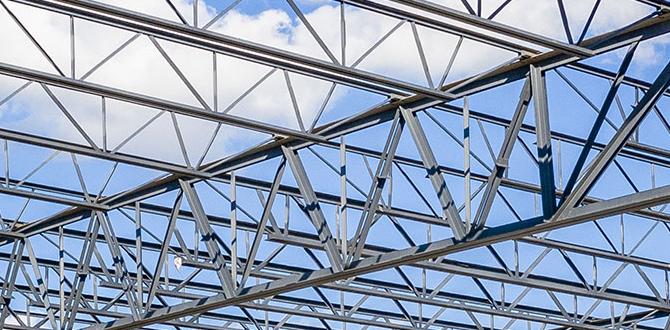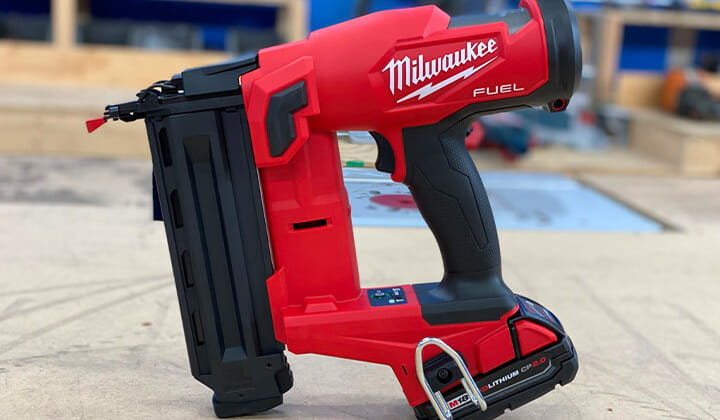Quick Summary:
Choosing between pneumatic and electric nail guns depends on your project’s needs and power source. Pneumatic offers maximum power and speed for serious DIY or professional work, while electric provides convenience and portability without an air compressor. This guide breaks down the pros of each to help you make the best choice.
Hey there, fellow DIYers and woodworking enthusiasts! Jack Shaffer here from Nailerguy, ready to help you conquer your next project. Have you ever stood in the tool aisle, staring at all those nail guns, feeling a bit overwhelmed? You’re not alone! Figuring out whether to go with a pneumatic (air-powered) or an electric nail gun can feel like a big decision, especially when you want the job done right without a headache. Don’t worry, though! We’re going to break it all down, nice and simple. By the end of this guide, you’ll know exactly which type of nailer is your perfect workshop buddy. We’ll explore the fantastic benefits of both, so you can feel confident in your choice. Let’s get nailing!
Table of Contents
Unpacking the Power: Pneumatic vs. Electric Nail Guns
So, what’s the big difference between these two types of nail guns? At their core, they both do the same job: driving nails into wood or other materials with impressive speed and precision. The magic happens in how they get their power. This difference in power source is where all the pros and cons really shine through. Understanding this is the first step to picking the right tool for your toolbox. Let’s dive into what makes each one tick and why you might choose one over the other for your specific projects.
The Mighty Pneumatic Nail Gun: Power Through Air
Pneumatic nail guns have been the backbone of many construction and woodworking shops for decades, and for good reason! They run on compressed air, supplied by an air compressor. Think of that compressor as the heart of the operation, pumping air at high pressure to power the nail gun’s firing mechanism. This system generally means serious driving force, making them ideal for tougher jobs and high-volume nailing.
Pros of Pneumatic Nail Guns
These workhorses come with a set of advantages that make them a favorite for many:
- Unmatched Power: Pneumatic nailers are known for their raw power. They can easily drive larger nails, sink them deeper, and handle hardwoods or dense materials without breaking a sweat. This is crucial for framing, roofing, and other heavy-duty tasks.
- Speed and Efficiency: The compressed air system allows for incredibly fast firing rates. You can lay down nails much faster than with other methods, significantly speeding up your project completion time, especially for repetitive tasks like installing trim or siding.
- Lightweight Tool: While you need a compressor, the nail gun itself is often lighter than its electric counterparts. This is because the motor and power source are in the compressor, not the tool itself. This reduced weight can mean less fatigue during long work sessions.
- Reliability and Durability: Pneumatic nailers are typically built for heavy daily use. Their simpler mechanics (compared to some electric models with batteries and motors) often translate to longer lifespans and fewer mechanical issues.
- Versatility: The pneumatic system is a platform for a huge range of nailer types, from tiny brad nailers for delicate trim work to powerful framing nailers for structural beams. One compressor can power many different tools.
- Cost-Effective for High-Volume Use: While the initial investment in a compressor can be significant, the cost per nail driven over time is very low. The nail guns themselves are also often less expensive than high-end cordless electric models.
Cons of Pneumatic Nail Guns
It’s not all air and sunshine, though. There are a few things to consider:
- Requires an Air Compressor: This is the biggest hurdle. You need a bulky, noisy air compressor and an air hose to operate a pneumatic nailer. This adds cost, takes up space, and limits portability.
- Hose Management: The air hose can get in the way, creating a tripping hazard or snagging on obstacles. You need to be mindful of its placement.
- Noise Level: Air compressors can be quite loud, which might necessitate hearing protection and can be disruptive in residential areas.
- Maintenance: Air compressors and pneumatic tools require some maintenance, like draining water from the tank and ensuring proper lubrication.
- Initial Investment: Buying a good quality air compressor and hose setup can be a significant upfront cost.
The Convenient Electric Nail Gun: Power in Your Hand
Electric nail guns have come a long way, offering fantastic solutions for DIYers and those who prioritize ease of use and portability. These are powered either by a cord directly from an outlet or by a battery pack (cordless electric). This means no air compressor, no hoses, just plug it in or pop in a charged battery and go!
Pros of Electric Nail Guns
Electric nailers bring a whole new level of convenience to nailing:
- Portability and Freedom: Cordless electric nailers are king here. No compressor, no hose means you can take them anywhere – up a ladder, across the yard, or to a job site without power. They offer ultimate freedom of movement.
- Ease of Use: They are generally very user-friendly. Just plug it in or charge a battery, and you’re ready to fire. Setup is minimal.
- No Air Compressor Needed: This is a massive pro. It saves space in your workshop, reduces noise, and eliminates the ongoing cost and maintenance of an air compressor. Learn more about essential tools for a home workshop at This Old House.
- Suitable for Many DIY Projects: For tasks like installing baseboards, casing, delicate trim, or assembling furniture, electric nailers provide enough power and excellent precision.
- Quieter Operation: While not silent, electric nail guns are generally quieter than their pneumatic counterparts, especially when you factor in the compressor noise.
- Cost-Effective for Occasional Use: For homeowners who only tackle a few projects a year, the cost of an electric nailer (especially if you already have compatible batteries from other tools) is often less than buying a compressor and a pneumatic gun.
Cons of Electric Nail Guns
Of course, there are trade-offs:
- Less Power: Generally, electric nailers don’t have the sheer driving power of pneumatic models. They might struggle with very dense hardwoods or driving nails deep into thick material.
- Slower Firing Rate: They can’t typically match the rapid-fire speed of pneumatic nailers, which can slow down large jobs.
- Battery Dependency (Cordless): You are limited by battery life. For extended projects, you’ll need spare batteries and time to charge them, adding to downtime and overall cost if you don’t have them.
- Heavier Tool (Cordless): The battery pack adds weight to the tool itself, which can lead to fatigue more quickly during prolonged use compared to sometimes lighter pneumatic guns.
- Higher Tool Cost (High-End Cordless): While basic corded electric nailers are affordable, high-performance cordless models can be quite expensive, especially when you factor in the cost of batteries and a charger.
- Potential for Jamming: Some users report that certain electric models can be more prone to jamming than their pneumatic cousins.
Key Differences at a Glance: Pneumatic vs. Electric Nail Guns
To make it even clearer, let’s put the main differences side-by-side:
| Feature | Pneumatic Nail Gun | Electric Nail Gun (Cordless) |
|---|---|---|
| Power Source | Compressed Air (via Air Compressor) | Rechargeable Battery |
| Power Output | High – Excellent for dense materials and deep drives | Medium – Good for most DIY and trim work |
| Speed/Firing Rate | Very High – Ideal for repetitive tasks | Medium to High – Can be slower for large jobs |
| Portability | Limited by hose and compressor; tool is lighter | High – Ultimate freedom of movement; tool is heavier with battery |
| Setup Time | Longer ( compressor, hose, power) | Shorter (charge battery, insert) |
| Noise | High (compressor is loud) | Medium (nailer itself) |
| Maintenance | Compressor and tool maintenance | Battery charging and tool cleaning |
| Initial Cost | Higher (compressor + tool) | Variable (can be high for premium cordless) |
| Best For | Framing, decking, roofing, high-volume work, job sites | Trim, molding, DIY projects, portability needs, occasional use |
Which Nail Gun is Right for You? Practical Advice from Nailerguy
Now that we’ve laid out the pros and cons, how do you actually decide? It really boils down to your typical projects and your priorities.
Consider Your Projects
Ask yourself these questions:
- What kind of materials will I be working with? If you’re often dealing with dense hardwoods, thick lumber, or need to sink nails flush into very strong materials, a pneumatic nail gun will likely serve you better due to its superior power.
- How big are my projects? For extensive projects like building a deck, framing a shed, or installing a large amount of siding, the speed and power of a pneumatic system will save you a tremendous amount of time and effort.
- Am I working on delicate trim or furniture? If your focus is on delicate tasks like installing interior trim, baseboards, crown molding, or assembling fine furniture, an electric brad nailer or finish nailer will likely be perfect. They offer great control and finish without overpowering the material.
Think About Your Workspace and Portability Needs
- Do I have space for an air compressor? Air compressors can be noisy and take up significant floor space in a garage or workshop. If space is tight or noise is an issue, electric might be the way to go.
- How often will I need to move my tools? If you find yourself working in various locations around your property, up ladders, or on job sites away from a power outlet, a cordless electric nailer offers unparalleled freedom.
- DIYer vs. Professional: For the serious DIYer or professional who uses a nail gun daily, the power, speed, and longevity of a pneumatic system are often worth the investment in a compressor. For the hobbyist or homeowner with occasional projects, the convenience of electric is hard to beat.
Budget vs. Long-Term Value
While a cordless electric nailer might seem like a good deal upfront if you avoid the compressor cost, consider the long run. If you plan on doing a lot of woodworking or construction projects over many years, the durability and lower cost-per-nail of a pneumatic system (once the compressor is purchased) can be more economical. For lighter, more occasional use, an electric nailer is often the more practical and cost-effective choice.
Understanding Nailer Types
Both pneumatic and electric nail guns come in various forms, each designed for a specific purpose. Knowing these can help you choose the right nailer within your chosen power type:
- Framing Nailer: The biggest and most powerful, designed for structural framing of houses and large projects.
- Siding Nailer: Designed for attaching siding materials, often with a specific angle to reach tight spots.
- Roofing Nailer: Features a large head to secure roofing shingles effectively.
- Finish Nailer: Drives thin nails with small heads (like 15-gauge or 16-gauge) for trim, molding, and casing. These are very popular in both pneumatic and electric forms for DIYers.
- Brad Nailer: Similar to a finish nailer but drives even thinner nails (e.g., 18-gauge) with minimal marring, perfect for delicate trim and craft projects.
- Pin Nailer: Drives tiny headless pins (e.g., 23-gauge) for applications where the fasteners need to be practically invisible.
For beginners often looking at common home improvement tasks, a finish nailer or brad nailer is a fantastic place to start, and you can find excellent options in both pneumatic and electric versions.
Essential Accessories for Your Nail Gun Adventure
No matter which type of nail gun you choose, there are a few accessories that can make your life easier and safer. For pneumatic nailers, this includes a good quality air hose, couplers, and potentially an air filter/regulator. For electric nailers, extra batteries and a reliable charger are key. Of course, always ensure you have safety glasses! For more information on tool safety, the Occupational Safety and Health Administration (OSHA) offers great resources.
Frequently Asked Questions About Nail Guns
Let’s tackle some common questions:
Q1: Can I use a pneumatic nail gun without a compressor?
A1: No, pneumatic nail guns absolutely require an air compressor to supply the compressed air needed to fire the nails. They are fundamentally reliant on this external air source.
Q2: Are electric nail guns powerful enough for all DIY projects?
A2: For most common DIY projects like installing trim, baseboards, and light framing, yes, electric nail guns are powerful enough. However, for very dense hardwoods or extensive structural framing, you might find pneumatic tools offer a more robust performance.
Q3: Which type of nail gun is better for beginners?
A3: For absolute beginners prioritizing ease of use and minimal setup, a cordless electric nailer (especially a brad or finish nailer) is often recommended. They offer a straightforward experience without the added complexity of air compressors.
Q4: How much do pneumatic and electric nail guns typically cost?
A4: A basic pneumatic nail gun can cost between $40-$150, but you also need an air compressor, which can range from $100-$500+. Cordless electric nailers can range from $80-$300+, with high-end models costing more, especially with batteries and chargers.
Q5: Can I run a pneumatic nail gun off a portable electric inflator?
A5: Generally, no. Most portable electric inflators do not supply enough sustained airflow or pressure (PSI) to properly operate a pneumatic nail gun. You need a dedicated air compressor designed for tool use.
Q6: Do electric nail guns require special nails?
A6: Electric nail guns use nails that are compatible with their specific type (brad, finish, etc.) and gauge, just like their pneumatic counterparts. You just need to ensure you buy the correct size and type of nails designed for your specific nail gun model.
Q7: Is a pneumatic nail gun better for framing?
A7: Yes, for professional framing and heavy-duty construction, pneumatic framing nailers are almost universally preferred due to their superior power, speed, and durability, allowing for faster completion of large structural tasks.
Conclusion: Making Your Nail Gun Choice
So there you have it – the essential breakdown of pneumatic versus electric nail guns! Whether you’re drawn to the sheer power and speed of a pneumatic system for big jobs, or you crave the ultimate convenience and portability of a cordless electric model for your DIY endeavors, there’s a perfect tool out there for you. Remember, the right nail gun isn’t just about driving nails; it’s about empowering you to build, create, and complete your projects with confidence and ease. Consider your typical projects, your workspace, and your budget. Most importantly, have fun with your woodworking journey!



